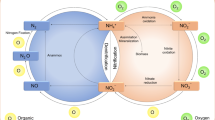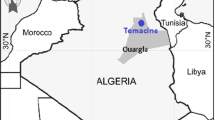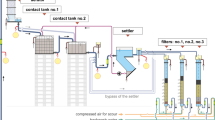Abstract
During the recent decades, the increasing trends in nitrate ion concentration in ground water sources have meant more research to find effective procedures for the prevention of even more water contamination by nitrogen sources. In this study a pilot was designed to examine the application of biological method for eliminating nitrate from the water of well No.903 of Mehrabad Airport, Tehran, Iran. Design, installation and running processes were done from April to November 2003. A fixed biological bed containing five-centimeter trunk pipes 16 mm in diameter were installed in the reactor and the system was operated with upflow current. Instead of Methanol, Acetic acid was used as the carbon source because of its easier acceptance by the public, lower price and availability as well as easier storage. The pilot was run in different hydraulic retention times from 48 h up to one hour. Considering economical, operational and maintenance factors, retention time of 2 h was determined to be optimum, in which 77% nitrate removal was achieved. Considering a ratio of 2 for COD/N, inlet COD of about 140 mg/L and the optimum retention time, COD removal of about 80% is also accomplished in this process. The amount of nitrite concentration, pH values, COD and turbidity is also evaluated versus different hydraulic retention times.
Similar content being viewed by others
References
AWWA, (1998). Treatment process selection for particle removal. American Water Works Association, McGraw-Hill.
Bouchard, D. C., Williams, M. K. and Surampalli, R. Y., (1992). Nitrate contamination of groundwater: Sources and potential health effects. J. AWWA., 193–232.
Chapman, D., (1997). Water quality assessments, 2ed. Ed. WHO, UNESCO publications.113-137.
Degremont, G., (1991). Water treatment handbook,Sixth edition, Paris, Firman, France. 1, 201–259.
Hammer, M. J., (1986). Water and wastewater technology. Prentice Hall International Publication. 101–121.
John De Zuane, P. E., (1990). Handbook of drinking water quality standards and control. Second edition, John Wiley Publication, 87–90.
Master, G. M., (1991). Introduction to environmental engineering and science. Prentice Hall International Publication. 56–93.
Mesdaghinia, A. R. and Shariat, M., (1998). Investigation Project on the environmental aspects of industries in Tehran, Phase. I. Department of Environmental Health Engineering, TUMS Publication, 1–2.
Senju, K., Nishi, N., Matsumaru, M. and Minegishi, R.: Waste water treatment efficiency and applications using yeast-hydrocarbonic wastewater treatment. Kougai to Taisaku, 25, 1557–1563.
Thanth, N. C. and Simard, R. E., (1973). Biological treatment of wastewater by yeasts. Water Pollution Control Fed, 45, 674–680.
Torabian, A., B. Aminzadeh and M. R. Ghaffarzadeh. (1998). Denitrification of Drinking Wate by Upflow Fixed Bed Reactors Water Waste J., 36, 12–17.
Torabian, A., B. Aminzadeh; S. H. Hashemi. (2002). A Study of nitrate in Tehran ground water and a method of removal, Int. J. Environ. Stud., 57, 725–734.
WHO, (1996). Guidelines for drinking water quality, addendum, 2nd. Edition, World Health Organization, 2, 63–77.
Author information
Authors and Affiliations
Corresponding author
Rights and permissions
About this article
Cite this article
Bidhendi, G.R.N., Nasrabadi, T., Vaghefi, H.R.S. et al. Biological nitrate removal from water resources. Int. J. Environ. Sci. Technol. 3, 281–287 (2006). https://doi.org/10.1007/BF03325935
Received:
Revised:
Accepted:
Published:
Issue Date:
DOI: https://doi.org/10.1007/BF03325935




